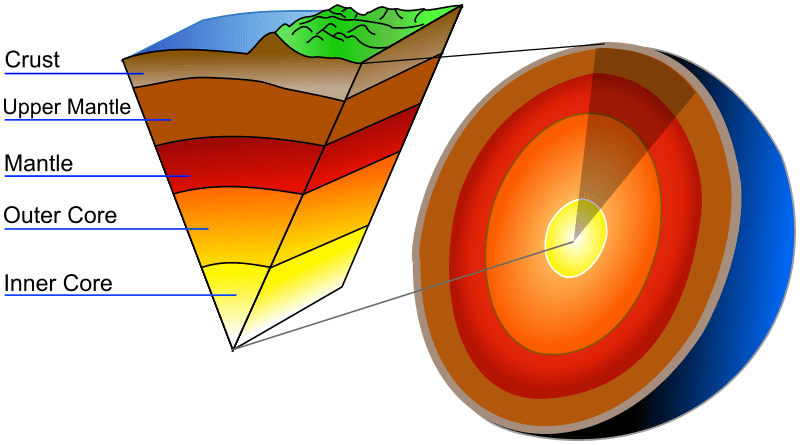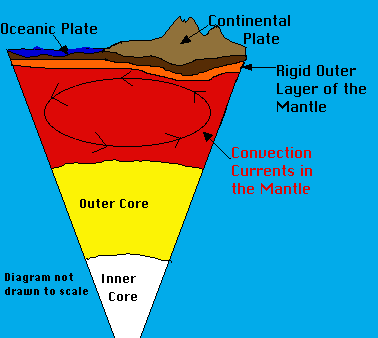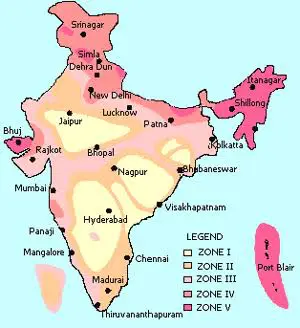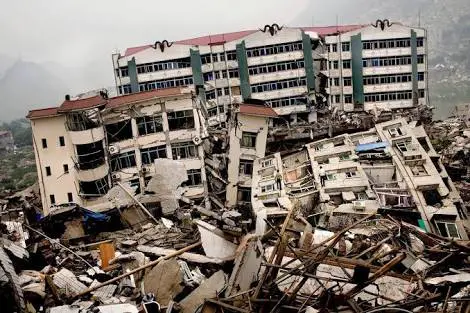India is one of the disaster prone countries, susceptible to almost all natural disasters. About 85% area is susceptible to one or multiple disasters and about 57% area is in high seismic zone including the capital of the country. The term earthquake when mentioned generally creates a sense of panic in the minds of people. They are neither preventable nor predictable.
Earth structure is made up of mainly three layers i.e. core, mantle, and crust. In the word “EARTHQUAKE” quake means seism i.e. shaking and vibration at surface of the earth resulting from underground movement along a fault plane. When earthquake occurs, a building undergoes dynamic motion; this is because the building is subjected to inertia forces that act in opposite direction to the earth’s motion. To prevent disaster it requires engineering applications to build the structure strong enough to withstand the impact of earthquake and to minimize its impact.

How Earthquake Develops
Earthquake is developed due to natural causes such as, tectonic plate movement, dislocation of earth’s crust, volcanic activities, pressure of gases in the interior.
1. Tectonic Plate Movement
Tectonic plates are present in the outer most layer of earth i.e. crust. Crust of earth is further divided into two layers i.e. oceanic plate and continental plate. The earthquake occurs when the continental plates collides against the oceanic plate. The oceanic plate is driven over by the continental plate. The driving force behind plate tectonics is convection (vertical transfer of heat due to fluid motion) in the mantle.

2. Dislocation of Earth's Crust
Earthquakes are also caused due to dislocation of crust of earth.
3. Due to Volcanic Activity
Earthquake is also caused due to movement of magma. It cracks the rock due the pressure; every time the rock cracks it makes a small earthquake.
4. Pressure of gases developed inside the earth
Mantle of earth constitutes mainly silicates in the form of olivine, garnet, pyroxene and also contains magnesium oxide, iron, aluminum, calcium, sodium, potassium, which if contracts and expands causes sudden shake on the earth’s surface.
Seismic Zones In India
INDIA lies on the Indian plate, a major tectonic plate which causes severe earthquake such as in Gujarat, 2001 and in Kashmir, 2005. The destruction an earthquake causes depends on its magnitude and duration. Earthquake can deform the ground, make structures to collapse and create tsunamis.
Civil engineering division council has approved a draft, INDIAN STANDARD 1893:1962(IS 1893:1962) which was revised in 2002 after Gujarat earthquake. The seismic zone is revised with four zones, instead of five zones. Zone 1 has been merged in zone 2.

Seismic Zone - 2
Zone 2 is under minimum intensity seismic risk with zone factor of 0.10 (i.e. maximum horizontal acceleration experienced by structure in this zone is 10% of gravitational acceleration). Regions which come under this zone are Ajmer, Allahabad, Bangalore, Gulbarga, Hyderabad, Jodhpur, Kota, Mysore, Nagpur, Pondicherry, and Vishakhapatnam.
Seismic Zone-3
Zone 3 is moderate risk zone with zone factor of 0.16. It covers regions of western Himalayas, Ahmadabad, Bokhara, Chennai, Rajkot, Bhavnagar, Surat, Mumbai, Agra, Bhiwandi, Gaya, Nasik, Kanpur, Pune, parts of central India, Bhubaneshwar, Cuttack, Calicut, Asansol, Kochi, Kolkata, Varanasi, Bareily, Lucknow, Dhanbad, Vodadara, Trivandpuram, Manglore, Coimbatore and Kozhikode.
Seismic Zone-4
Zone 4 is high risk zone of high intensity earthquakes with zone factor of 0.24 . It covers regions of Almora, Ambala, Amritsar, Balraich, Barauni, Bulandshahar, Chandigarh, Darjeling, Dehradun, Ghaziabad, Delhi, Gorakhpur, Jamunanagar, Jalandhar, Ludhiana, Moradabad, Nainital, Patna, Pilibhit, Roorkee, Meerut and Shimla.
Seismic Zone-5
zone 5 includes area of highest risk with zone factor of 0.36 . It covers parts of Kashmir, Bhuj, north-east part of Bihar, north east of Indian region, Runn of kutch.
importance of Seismic Factor in Construction
Earthquake can cause cracks, settlement and dislocation of plumbing and electrical lines in the structures. Structures need to be designed to withstand these forces and deformations. To resist these forces, seismic code (IS 1893:2002) has to be followed to improve the stability and durability of structure so that they may withstand earthquakes.
A seismic code guides engineers to construct structures which can resist seismic waves. During construction of buildings, structure engineer should take into account the seismic factors which are provided according to the zones ranging from 0.1-0.36.

It is important to note that seismic coefficient has been considered during construction otherwise may result in failure of structure during earthquake. It is failure of buildings due to earthquake which causes loss of life on large scale. In present scenario, seismic factor consideration is as important as considering dead and live loads on structures.
properties for a earth Quake Resistant Building
- Good Structural Configuration: Its geometrics properties and joints should be such that they ensure a direct and smooth transfer of inertial forces to the ground.
- Lateral Strength: The maximum lateral forces that it can resist should be such that structure remains safe.
- Adequate Stiffness: The lateral load resulting system should be stiff enough, that earthquake induced deformations do not damage its content.
- Good Ductility: Structure should have capacity to go under large deformations under earthquake without failure.
Structures constructed following IS Codes are considered to be safe during natural calamity. So, Always confirm that your Structural Engineer has followed IS Codes during the design and construction of your House.





